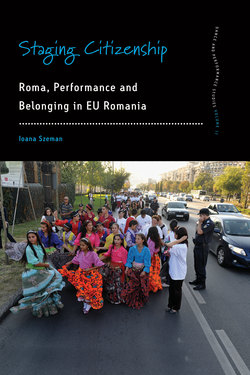Читать книгу Staging Citizenship - Ioana Szeman - Страница 13
На сайте Литреса книга снята с продажи.
Persecution and Erasures in the Twentieth Century
ОглавлениеBetween the two world wars, the unification of several territories into Greater Romania was marked by the Romanian state’s increased attempts to assimilate other ethnicities (Livezeanu 1995). Roma activists and intellectuals in organizations such as the General Association of Ţigani in Romania and the General Union of Roma worked to establish a public Roma presence and to craft a modern identity – one based on integrating Roma through an emphasis on their Christian values (Potra, 1939). Despite the fact that Roma were recognized as an ethnicity, they were not included in the constitution, and the majority of Roma were impoverished and uneducated.
Perhaps the darkest period for Roma across Europe was the Roma Holocaust during World War II. Alongside Jews and homosexuals, Roma were the target of Nazi and fascist extermination campaigns. In Romania, Marshal Ion Antonescu sent around 25,000 Roma to concentration camps in the territories of today’s Ukraine.
While slavery and the Holocaust were extreme examples of the marginalization of Roma, their state-sanctioned marginalization has operated as a veiled or explicit policy across different historical periods. For five decades during socialism in Romania, the Roma were treated as a social problem, their culture was not recognized or even mentioned in official documents and they were the target of assimilation campaigns. Through assimilation policies Roma and their contribution were appropriated by the nation and erased, while the stereotypes of the abject Ţigani persisted and were unofficially used to refer to Roma who failed to assimilate. From 1965 to 1989 Romania was ruled by Nicolae Ceauşescu, whose regime started with a few years of relative freedom before turning into a dictatorship that aggressively controlled the population. In this period ethnic nationalism flourished in Romania (Verdery 1991), and most Roma failed to assimilate. The socialist regime recognized ‘cohabitating nationalities’ (excluding Roma), and officially fostered a multinationalism in which majority and minority institutions coexisted but did not intersect – a system that continues today, and which in this book I term the normative monoethnic performativity of ethnocultural identities. Stereotypes about Ţigani as thieves, criminals and outcasts proliferated, despite the Communist government’s official suppression of Roma identity. Roma became scapegoats for the majority, because of the alleged benefits that socialist propaganda claimed they received. Another effect of the Communist assimilation policies was the proletarianization of a large number of Roma through their employment in low-skilled jobs in factories or collective farms and their access to public housing. During socialism, the term ‘Ţigan’ was emptied of any positive or romantic connotations and became a synonym for the underclass. The stereotype of the poor Ţigani, however, presupposed the existence of the extremely rich traditional Ţigani. Despite their lack of success, Communist assimilation policies had lasting effects at the cultural, political, social and economic levels, all still visible in the context of post-socialist Romania.
The effects of various socialist cultural policies regarding the Roma in countries of the former Eastern bloc are also visible today in the preponderance of distinct stereotypes about Roma in each country, against a common background of marginalization and discrimination. Romania did not produce any films or cultural products identified as Roma or Ţigani in the five decades of socialism. In contrast, in nearby Hungary, despite similar policies, the resurgence of a Roma cultural movement and the presence of self-identified Roma musicians onstage allowed the Roma to be considered cultural agents (Kovalcsik 2010; Stewart 1997), something that Roma in Romania were denied. In socialist Yugoslavia, to mention another example, Roma were recognized as having a culture, even if not on a par with other nationalities, and they were represented, albeit stereotypically, in many films, including Aleksandar Petrović’s I Even Met Happy Gypsies (1967) and Emir Kusturica’s The Time of the Gypsies (1987). Kusturica’s films and Goran Bregović’s music were popular in Romania, but they did not change the general perception of local Roma – not even in the sense of producing romantic stereotypes.
The economic-political changes of the transition to neoliberalism affected most Roma profoundly, especially those working on collective farms, which were dismantled, or in low-skilled jobs in plants and factories that were closed down. Social security was also significantly reduced. Roma found themselves with a recognized ethnicity, but holding fewer economic rights and placed outside national and European citizenship. However, some of these changes benefited the nomadic or semi-nomadic Roma, most of whom had been unemployed during socialism and who recovered some of their goods and valuables confiscated by the socialist state.
Despite the change in paradigm in relation to Roma, from a social problem during socialism to an ethnoculture during post-socialism, the majority of Roma continue to experience marginalization, and their economic condition has worsened. However, while the majority of Roma are poor, there is a burgeoning middle class of Roma activists, intellectuals and successful entrepreneurs. Affluent Roma spark resentment and are associated with and blamed for the negative effects of the transition to a market economy. Because of long-standing suspicion against Roma, Roma success, whether in the entertainment industry or in business, is often resented by the majority and perceived as illicit.
